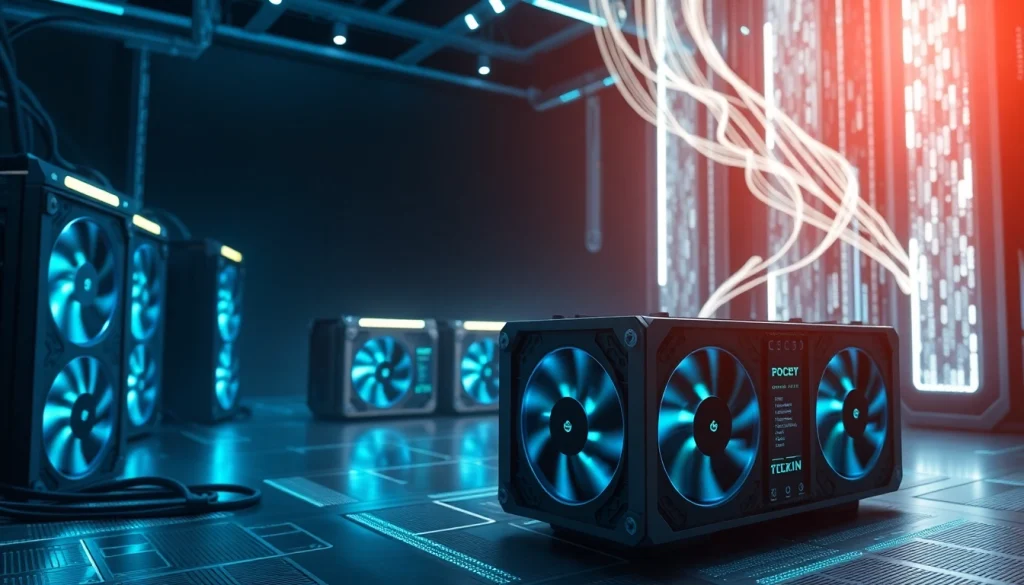
Understanding Bitcoin Mining Basics
Bitcoin mining is a pivotal process within the cryptocurrency ecosystem. It not only facilitates the entry of new Bitcoins into circulation but also plays an essential role in securing the Bitcoin network. As the demand for cryptocurrencies increases, understanding the intricacies of Bitcoin mining becomes increasingly crucial for potential miners and investors alike.
What is Bitcoin Mining?
At its core, Bitcoin mining is the procedure by which transactions are verified and added to the public ledger known as the blockchain. Miners utilize powerful computers to solve complex mathematical problems, commonly referred to as hashing. When a miner successfully solves a problem, they create a new block and are rewarded with a certain amount of Bitcoin. This ensures both the integrity of transactions and the overall security of the network.
The process of mining Bitcoin is highly competitive, requiring miners to continuously upgrade their hardware and software to keep up with the increasing difficulty levels set by the network. The Bitcoin mining difficulty adjusts approximately every two weeks, ensuring that new blocks are added to the blockchain roughly every ten minutes.
The Importance of Miners in the Bitcoin Network
Miners are essential to the Bitcoin network. They validate transactions, ensuring that double-spending does not occur. Without miners, the network would be susceptible to attacks and manipulation. The competitive nature of mining also ensures that no single entity can control the Bitcoin network, enabling its decentralized nature.
Moreover, miners contribute to the decentralized finance (DeFi) ecosystem. They participate by providing computational power to secure the network, which helps in establishing trust among users. The act of mining encourages participation in the network, which further strengthens the community surrounding Bitcoin.
Required Hardware for Bitcoin Mining
To successfully mine Bitcoin, one must invest in the right hardware. The hardware landscape for mining has evolved significantly since the inception of Bitcoin. Initially, it was possible to mine Bitcoin using standard personal computers, but as the network grew, so did the complexity of the mining process.
Today, the most efficient way to mine Bitcoin is through dedicated hardware known as Application-Specific Integrated Circuits (ASICs). These machines are specifically designed for hashing at incredibly high speeds while using less power than traditional computing setups. Examples of popular ASIC miners include the Bitmain Antminer series and the MicroBT Whatsminer series.
Setting Up Your Bitcoin Mining Operation
Choosing the Right Mining Software
The mining hardware is just one half of the equation. Equally crucial is the software used to manage the mining process. There are several commercial and open-source mining software options available in the market.
Popular mining software includes CGMiner, BFGMiner, and EasyMiner. Each software offers various features, user interfaces, and compatibility with different hardware setups. Factors to consider when selecting mining software include ease of use, community support, compatibility with mining hardware, and overall performance efficiency.
Electricity and Cooling Considerations
Electricity consumption is one of the most significant costs associated with mining Bitcoin. Miners often need to calculate the electricity usage of their mining rigs to ensure profitability. Electricity prices vary by region, and potential miners should seek areas with the cheapest energy costs for optimal returns.
Additionally, the cooling of mining hardware is vital due to the immense heat generated from prolonged operation. Implementing efficient cooling systems, whether through air conditioning, industrial fans, or immersion cooling solutions, can extend the life of the mining equipment and reduce operational issues.
Joining a Mining Pool: Pros and Cons
Joining a mining pool can benefit individual miners, especially those with limited resources. A mining pool allows multiple miners to work together, combining their computational power to increase the chances of solving a block. The rewards are divided among participants based on their contributed mining power.
However, there are both pros and cons associated with mining pools. The primary advantage is a more consistent payout, mitigating the uncertainty of mining solo. Conversely, joining a pool means that a portion of the earnings must go to pool operators, and some pools may impose additional fees. Miners should weigh these factors based on their individual circumstances and goals.
Advanced Bitcoin Mining Techniques
Optimizing Mining Collateral and Costs
For miners, optimizing operational costs is essential for sustaining profitability. This includes considering factors such as mining difficulty, Bitcoin’s market price, and operational expenses. Miners can enhance their profitability by improving their mining efficiency and choosing the most favorable conditions in which to mine.
Some advanced miners also leverage financial derivatives and exchange strategies to hedge their exposure to Bitcoin price fluctuations. For instance, participating in futures contracts can provide an insurance mechanism for their mined coins against falling prices.
Monitoring Mining Performance
Tracking the performance of a mining operation is crucial for ongoing optimization. Various software tools and dashboards are available to help miners monitor hash rates, temperatures, and power consumption. Metrics to focus on include hash rate (the speed at which a miner can perform the hash function) and mining efficiency (the number of Bitcoins earned based on energy consumed).
Regular analysis of these metrics enables miners to make informed decisions, whether it involves adjusting operational strategies, upgrading equipment, or even opting for a different mining pool.
Using Cloud Mining Services Effectively
Cloud mining offers a unique alternative to traditional mining. It allows individuals to rent processing power from remote data centers instead of maintaining physical hardware. Cloud mining services can be particularly appealing for those daunted by the initial costs of hardware setup and maintenance.
Nevertheless, potential miners should carefully research cloud mining options and providers to avoid scams and poorly operated services. Reading reviews, understanding contract terms, and checking the service’s operational history can mitigate risks associated with cloud mining.
Challenges in Bitcoin Mining
Dealing with Network Difficulty Adjustments
One of the most significant challenges faced by Bitcoin miners is the constant adjustment of mining difficulty. As more miners join the network, the complexity of the mathematical problems increases, requiring advanced technology and strategies to remain competitive.
This evolving difficulty can make it challenging for smaller-scale miners to earn returns on their investments. It necessitates staying updated on market trends and technology advancements, as well as being willing to adapt one’s mining strategies accordingly.
Addressing Environmental Impact
The environmental impact of Bitcoin mining has garnered increasing attention and scrutiny. The high electricity consumption associated with mining operations has led to discussions about the carbon footprint of the Bitcoin network.
To address these concerns, miners are exploring more sustainable energy sources, such as solar, wind, and hydroelectric power. By transitioning to renewable energy, miners can reduce their environmental impact while improving their bottom line, especially in regions with abundant natural resources.
Future Challenges for Bitcoin Miners
Looking ahead, Bitcoin miners face several challenges, including changes in regulations and the overall evolution of the blockchain ecosystem. Governments worldwide are increasingly scrutinizing cryptocurrencies and may impose new regulations impacting operations.
Additionally, technological advancements could introduce new mining algorithms or consensus mechanisms that might render traditional mining methods obsolete. Miners must stay informed and agile to adapt to these potential transformations.
The Future of Bitcoin Mining
Trends in Bitcoin Mining Technology
As the industry evolves, various trends are emerging in Bitcoin mining technology. Innovations are helping miners operate more efficiently, with the development of more powerful ASIC miners that outpace their predecessors in terms of speed and energy efficiency.
Furthermore, advancements in software capable of optimizing mining performance and better analytics tools to monitor operations are essential in staying competitive. The integration of artificial intelligence and machine learning into mining operations could also play a significant role in future mining strategies.
Regulatory Changes and Their Impact on Miners
Regulatory changes will profoundly influence the landscape of Bitcoin mining. As governments begin to enact laws regarding cryptocurrency mining, miners must remain vigilant and compliant. These regulations may dictate where mining farms can operate, the energy sources they can use, and their overall operational legitimacy.
Moreover, miners and investors alike should understand the implications of these regulations on market dynamics, as they can significantly affect profitability and overall industry health.
The Role of Bitcoin Mining in Decentralized Finance
Bitcoin mining plays a crucial role within the decentralized finance (DeFi) ecosystem. By providing security and trust to the network, miners enable decentralized applications (dApps) to function effectively. The interaction between miners and smart contracts brings forth opportunities for synergy, with miners potentially participating in rewards from dApps.
Moreover, as DeFi continues to gain traction, miners may find new income avenues tied to other cryptocurrencies and blockchain projects, opening additional channels for revenue generation beyond Bitcoin mining itself.
As the future of Bitcoin and the broader cryptocurrency universe unfolds, staying informed and adaptable will empower miners to navigate challenges and leverage opportunities in this exciting landscape.






